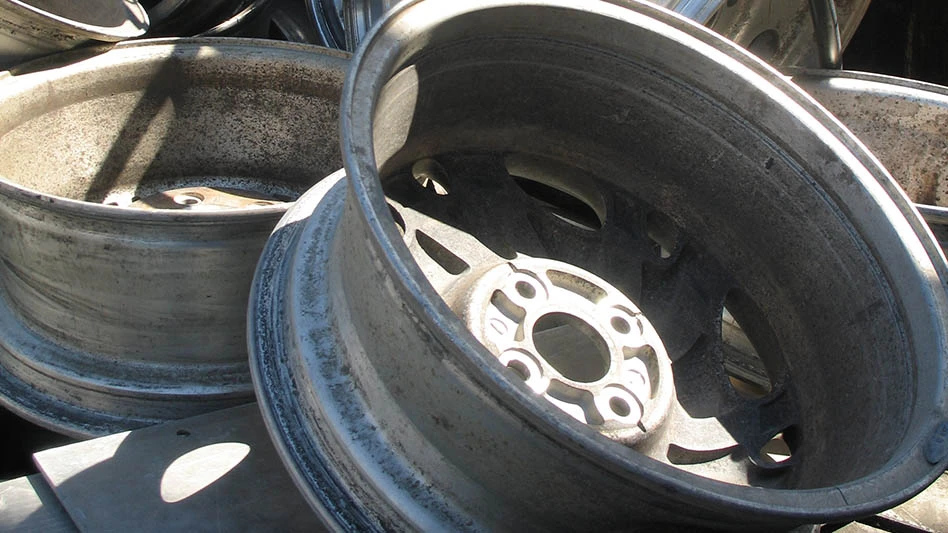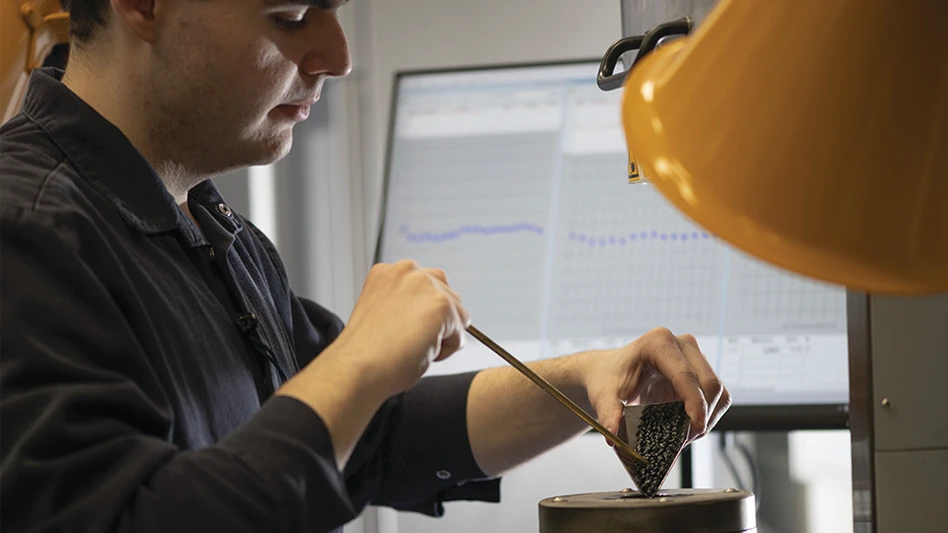The state with the largest registered vehicle population is also the state that has the biggest scrap tire problem. In 1997, motor vehicles in California generated 30 million scrap tires. That figure represents just more than one-eighth of all scrap tires generated annually in the United States.
Leading the charge against illegal scrap tire piles and lending a helping hand to tire recyclers is the six-member Integrated Waste Management Board based in Sacramento, Calif. It is one of six boards and departments within the California Environmental Protection Agency. The Waste Board is responsible for protecting the public’s health and safety and the environment through management of more than 52 million tons of solid waste generated in California each year. Its mandate is to work in partnership with local government, industry and the public to achieve a 50% reduction in waste disposed by the year 2000, while at the same time ensuring environmentally-safe landfill disposal. Because of the Waste Board’s efforts, California’s diversion rate is currently at an all-time high of 32%.
As for scrap tires, the Waste Board is using a three-prong approach to tackle the problem. The first prong is identifying illegal tire piles for clean up, then provide the funds to accomplish the job. The second prong is market development, as the Waste Board looks to enhance end products through the establishment of special recycling zones and grants. The final prong is balanced enforcement action. This is accomplished through scrap tire hauler licenses, public education and by targeting recyclers, collectors and processors that are not in compliance.
Annually, the Waste Board spends about $75 million on waste management measures, and of that about $5 million annually is spent on scrap tire initiatives.
Cleaning Up
From the Oregon border to Mexico, California is faced with the challenge of reusing, recycling and safely managing not only the 30 million waste tires generated each year, but another 25 to 30 million tires already stockpiled throughout the state. The Waste Board allocates money for clean up operations from the California Tire Recycling Management Fund that began in 1989. Prior to 1997, the fund was supported by a 25-cent fee on each old tire returned to tire dealers by customers. After 1997, that 25-cent fee was assessed on all new tire sales instead.
"Clearing California’s landscape of dangerous waste tires is one of our major initiatives," says Daniel Pennington, chairman of the Waste Board. "The public health and environmental safety threats waste tires pose when they are illegally dumped are challenges the Waste Board will meet. Illegal disposal represents lost opportunities to recycle and the recycling-related jobs."
Most of the illegal scrap tire piles are located in rural or desert areas. The unpermitted stockpiles are fire hazards, containing few defenses, such as access pathways, safe tire stacking configurations, fire-fighting equipment on site and nearby water supplies, drainage culverts and secured perimeters. All of these safeguards are required of state-permitted facilities. In addition, illegal tire piles attract rodents and are breeding grounds for mosquitoes.
Scrap tire piles are cleared through grants to bonafide tire recyclers with the proper equipment, and by the use of local Conservation Corps members. The corps was organized by the state government to assist in small-site clean ups and along roadways and trails. They also serve to educate the general public about recycling, and in this case, about the importance of proper tire disposal.
Since 1995, the Waste Board has spent $3.8 million to clean up almost seven million tires illegally dumped in 22 sites around the state. Also, property owners and other responsible parties have been forced at their own expense to clean up 150 sites containing a total of just more than three million waste tires. This has saved the public an estimated $6 million to $10 million in clean up costs. Some recent clean up efforts include:
• $161,000 in grants for various local Conservation Corps groups to collect waste tires that were illegally dumped in communities statewide. Funds were also used for public education projects and to hold amnesty days for individuals to turn in waste tires without penalty.
•$535,000 to clean up an illegal waste tire pile in the Chittenden Pass area of San Benito County that held an estimated 80,000 to 100,000 scrap tires. The steep terrain, dense overgrowth, and nearby Pajaro River made removing the tires a difficult task, according to Pennington.
•$171,000 as part of the Waste Board’s Local Government Waste Tire Clean Up Matching Grant Program. The money was used in part to clean up 5,000 waste tires at the Plumas-Sierra Fairground. The tires were originally used in the ‘70s and early ‘80s as a crashwall for the racetrack. Funds were also used to clean up 2,000 tires illegally dumped on a stretch of land near the Rialto Airport and 75,000 tires illegally dumped on a residential area in Hesperia, as well as 20,000 waste tires that accumulated at the Loyalton Landfill since the 1970s.
•$558,000 to remove 217,000 waste tires from nine illegal sites scattered around four Southern California counties, including Riverside County, where an estimated 100,000 tires were piled on private property near Palm Springs.
•$260,000 to clean up an illegal 100,000-tire stockpile on 19 privately-owned acres in the vicinity of Garnet, just north of Palm Springs.
•$195,000 to eliminate a 75,000-tire illegal stockpile known as the Acacia Road Waste Tire Site in Hesperia left over from an abandoned tire shop.
•$450,000 to clean up more than one million tires at a site in Nipomo Mesa. The tires went to the Chicago Grade Landfill in Atascadero, where they were shredded and used as daily cover. The tire pile problem began in 1989 when the property owners signed a five-year lease with another party allowing the operation of a tire collection and recycling businesses at the site. Tires were collected in the hope of selling them to the now-defunct Rialto Power Plant in Southern California. The operator eventually abandoned the site in 1991, leaving behind the stockpile.
•$200,000 to remove 100,000 tires at the Tri-C Turkey waste tire pile in Kings County.
One tire pile of about 30,000 tires located on remote desert land in Riverside County between the Chocolate Mountains and Salton Sea, was also located near the San Andreas Fault and had hot mineral water bubbling up through the pile from the fault. The Waste Board eventually targeted the pile for clean up.
"Most of the tires in these various sites were stored in anticipation of future rising market values, but that simply has not happened," says Lanny Clavecilla, of the Waste Board’s public relations office, "or unlicensed tire haulers simply dumped them illegally after collecting their fees."
The Mother of All Piles
For some time, California has been home to the largest scrap tire pile in the Western U.S., and one of the largest in the world. The pile, now at about six million tires, is located in Modesto and has been a source of energy for the Modesto Energy Limited Partnership (MELP) energy plant near by. The pile, until recently, was being managed by Oxford Tire Recycling, which had agreed to completely clean up the pile by the end of 1999, according to Waste Board officials.
"Millions of waste tires have been stockpiled in the rugged canyons just west of Interstate 5 for more than 30 years, posing a significant threat to north-south transportation, the state’s electrical grid and Southern California’s water supply," says Pennington. "Resolving this potential crisis has been one of our top priorities at the Waste Board."
MELP has been burning tires to produce electricity since the mid-1980s, but was heavily subsidized by Pacific Gas and Electric under a contract struck at a time when energy prices looked like they would rise significantly. But deregulation of the electric-power industry actually decreased prices, and the MELP subsidy was not going to be renewed. Company officials were looking at a financial meltdown if they did not get help.
To ensure MELP’s survival, the Waste Board paid the company $1.7 million in 1997 to burn four million tires from the pile. OTR contributed $640,000 bringing the state’s net cost down to just under $1.1 million.
OTR, meanwhile, agreed to complete the clean up of the pile within 14 months after the four million tires were burned by MELP. Since MELP completed its part in May 1998, OTR was to have the remainder of the pile cleaned up by July 1999. But OTR’s lack of success in removing the remaining tires led to the Waste Board revoking its major waste tire facility permit in August 1998.
Waste Board officials are currently reviewing alternative clean up efforts for the site, but are still in discussions with OTR.
This huge tire pile began like most other tire piles during the 1950s, ‘60s and ‘70s. The owner of the land believed that one day the tires would be a valuable commodity. Since that revelation never came to pass, the pile kept growing until it finally become largest repository of scrap tires in the Western U.S., and one of the largest in the country. In 1995, OTR purchased the property with the tires.
The tire pile is especially worrisome to Waste Board officials because of its location adjacent to Interstate 5 and the California Aqueduct. If the site ever caught fire oil would seep into the canal, as well as destroy major north-south electrical transmission lines that run directly overhead. Also, a major fire would cause severe air pollution problems and could burn and smolder for months.
Helping Markets
Bedsides clean up activities, the Waste Board promotes markets for scrap tires, too. "It has always been our philosophy to promote recycling options for the millions of waste tires plaguing this state," says Pennington. "I’m pleased that we are able to fund projects that encourage reusable solutions to the waste tire dilemma."
The board is authorized to award grants to local agencies for the purpose of diverting tires from landfill disposal by promoting markets of recycled-content products. Some recent examples of areas where the Waste Board has given funds include:
•$25,000 to the San Francisco Conservation Corps to promote recycled tires as a low-cost, functional and attractive material for sustainable landscaping.
•$306,000 in grants to the cities of Carpinteria, Garden Grove, Lemoore, Soledad, and Yuba City, and school districts in the cities of Beaumont and Downey to purchase rubberized railroad levelers, new roofing materials and running track surfacing made from crumb rubber.
•$180,000 for projects involving the paving of roads and trails with a mixture of asphalt concrete and rubber from waste tires.
•$350,000 to help 20 school and municipal park districts around the state resurface playground areas with impact-absorbing rubberized mats made from waste tires.
•$500,000 to the Los Angeles County Rubberized Asphalt Concrete Technology Center to help keep the center operating for another two years. The center researches ways to advance the use of crumb rubber in paving applications. The half-million dollar boost will help the center stay open through June 2000. The Waste Board awarded the county the same amount in 1997 to help start the center’s operations.
If the application of rubberized asphalt to repave California’s extensive highway infrastructure becomes widespread, it has the potential to recycle up to 20% of the 30 million old tires thrown away annually.
Local governmental agencies are the largest users of rubberized asphalt in public paving projects and represent the biggest market growth segment for the product. Since opening in 1997, the center has become a one-stop technical and educational clearinghouse for local governmental agencies curious about using rubberized asphalt in projects.
However, unfamiliarity with the product, application methods, appropriate usage, and relevant cost benefits have been stumbling blocks to increased use of rubberized asphalt, despite the glut of waste tires in landfills and illegal dumpsites around the state.
In another effort, Total Tire Recycling, a company handling waste tires from throughout Northern California, was granted a new five-year operating permit by the Waste Board, allowing it to store up to 10,500 waste tires at its nearly five-acre site in southeast Sacramento.
"Total Tire Recycling is a good example of success in the waste tire industry," says Pennington. "Flourishing businesses like this are helping California deal with its burgeoning surplus of waste tires."
The Waste Board approved a Major Waste Tire Facility Permit for the operation after Total Tire Recycling agreed to meet a number of environmental, public safety, and financial assurance conditions required by state waste regulators and local health department officials.
The company currently handles a wide variety of waste tires from registered waste tire haulers. Upon arrival, workers sort out recyclable tires from each load, 35% of which are re-sold as used tires, while the rest are exported. Tires that cannot be recycled are shredded and sent to local landfills. Future plans for the facility include processing tires into crumb rubber products.
The Waste Board has also helped Golden-By Products Inc., Pasadena, approving the company’s permit to build a waste tire storage and processing facility in northern Merced County. The company plans to process up to 4 million waste tires yearly by its fifth year of operation by processing them into fuel for several energy-producing facilities in the San Joaquin Valley. Part of this tire-derived fuel will be used in the place of coal to generate electricity.
Formerly a producer of boiler fuel made from orchard prunings, stumps, and almond shells, Golden By-Products stopped that service after utilities in California were deregulated and it became no longer economically feasible to produce energy that way.
Elsewhere, a loan of $350,000 was given to Industrial Tire Service of Long Beach to triple its present workforce with 10 new jobs and divert 620 tons of rubberized waste from area landfills each year.
Industrial Tire Service will use the money to expand its tire recapping and retreading services by purchasing a larger building and more equipment. The company serves the Long Beach and Los Angeles harbor customers, retreading and repairing tires used on automobiles, forklifts, golf carts and other vehicles. The company’s use of a new retreading process will allow it to send less scrap rubber to landfills.
Industrial Tire Service has also begun offering tire disposal and recycling services.
B.A.S. Recycling Inc., San Bernardino, is another company that has received grant money from the Waste Board. The company collects scrap tires, processes them and makes crumb rubber. The crumb is sold and also molded into products. In business since 1989, B.A.S. recycling processes about 3.5 million tires a year making about 35 million pounds of crumb rubber annually.
"We sell mainly to the friction (brake) industry, and have been doing well in that area," says Mike Harrington, sales and marketing for B.A.S. Recycling.
Although Harrington would not say what price his company gets for crumb, he did say that B.A.S. Recycling receives anywhere from $1 to $1.50 per tire for pickups. "The market for crumb rubber and other products from scrap tires has been flat and remains so," he says.
Although Harrington is a believer in the Waste Board’s scrap tire initiatives, he says they can only do so much. "One problem is that crumb rubber can come in cheaper from outside the state and attack the markets no matter how much the government helps you," he says.
As for obtaining grant money, Clavecilla says that the procedures are not that difficult. Applicants simply need to fill out request forms with the Waste Board and provide the required information to obtain tire recycling grants. "The forms ask for specific operational information from each applicant," he says, "and the Waste Board tracks expenditures of public funds in accordance with laws governing this function. Applicants experiencing problems in obtaining grants are able to contact the Waste Board grants program for help in filling out applications and hurdling obstacles to financial assistance."
Overall, scrap tires have been successfully reused in California as acoustic filling in sound walls, in highway crash barriers, have been retreaded, exported, and made into crumb rubber products such as playground safety mats, floor tiles, and carpet underlay. Waste tires have also been safely combusted in California to generate electrical power and as a fuel supplement and additive in making of cement.
Playing the Enforcer
Because of the easy money that can be made by collecting tires for a fee then illegally dumping them, it is paramount that the Waste Board play a tough enforcer role.
"From metropolitan regions and suburbs to the remote deserts and mountains of rural California, no part of this state is immune to the nuisance and dangers of illegally dumped tires," says Pennington. "Our hope is that funds from the board will assist local governments in identifying those breaking the state’s tire handling laws, going after recalcitrant property owners, and where needed, cleaning up illegal piles in their communities."
Recent grants in this area include:
•$580,000 to help local governments identify waste tire piles and enforce laws against illegal tire dumping, as well as help additional communities clean up illegal sites.
•$410,000 to fund the Waste Board’s Local Government Waste Tire Enforcement Program. The cities and counties awarded the money conducted surveillance and inspection programs of waste tire sites, as well as compliance activities to provide operators with guidance about state tire handling laws, and if necessary begin initial enforcement actions.
This is the second year of the Waste Board’s Local Government Waste Tire Enforcement Program. In 1997, more than $100,000 was awarded to local governments for inspection and enforcement actions. In all, 525 tire dealers and auto dismantlers were inspected and enforcement actions were initiated against ten property owners. Additionally, 112 operators were found to be using unregistered tire haulers—often using haulers from Mexico. "Conducting inspections . . . of potential illegal waste tire sites is the first step in our effort to stop the illegal disposal of waste tires," says Pennington.
Through the grant program, the participating counties perform intensive inspections of waste tire facilities to ensure that the operators are following all tire facility regulations, including using registered tire haulers.
One small company that has endured all the regulations for the last 19 years is Tirex Tire Recycling, Redding. The company is owned by Keith Harrison, and employs his son and Tyler White, a sales representative. The company remains profitable with one truck and a small shredder, moving more than 100,000 tires annually.
While Tirex gets $1 per tire to dispose of it, it usually pays a local cement company about $27 a ton to burn the tires in a cement kiln. Tires are also shredded and sold to various companies at around $150 a ton.
"We are a small company supporting three people, but we have been in business for 19 years. Not many companies in this industry can say that," says White. "This business is very cutthroat. Someone can come in and undercut you by a nickel and the tire dealer will drop you in a heartbeat. But next year they are calling you because that other scrap tire hauler went out of business, or was doing something illegal."
"Right now, we are . . . happy that the Waste Board is doing its best to keep the illegal hauler out of our market," White adds.
Staying Aggressive
Where will the Board divert most of its money for scrap tires in the near-term future – toward clean up, enforcement or market development? "The successful establishment of economical markets for waste tires, by their nature, is expected to reduce the numbers of tires thrown away in California," says Clavecilla. "With less incentive to discard tires and more to recycle them in viable marketplaces, the Waste Board anticipates fewer illegal tire dumps. However, at this point, such comprehensive markets do not exist and clean up and enforcement activities remain an important responsibility of the Board."
Thus, Clavecilla does not count out continued illegal dumping. "The Waste Board has made inroads in cleaning up hundreds of illegal/abandoned waste tire piles and educating the public and industry on the many reuse values of tires," he says, "yet unlawful dumping remains a problem. In the most populous state in the nation, with the most numbers of automobiles, this fact is being aggressively addressed."
The author, a former Recycling Today managing editor, is a technical writer based in Parma, Ohio.

Explore the October 1998 Issue
Check out more from this issue and find your next story to read.
Latest from Recycling Today
- Tire Recycling Foundation names executive director
- Dock 7 named 2025 Exporter of the Year at New Jersey International Trade Awards
- Waste Connections reports ‘better than expected’ Q1 results
- Commentary: How EPR is transforming the packaging industry
- Acerinox names new North American Stainless CEO
- Greenwave closes 2024 books with red ink
- Steel Dynamics nets $217M on record shipments
- Massive Chinese steelmaking rebound recorded in March





